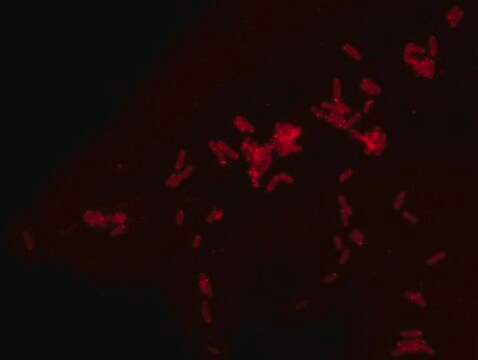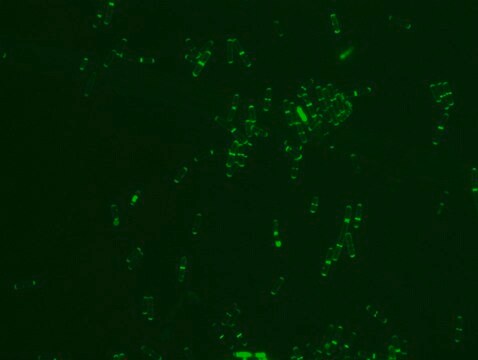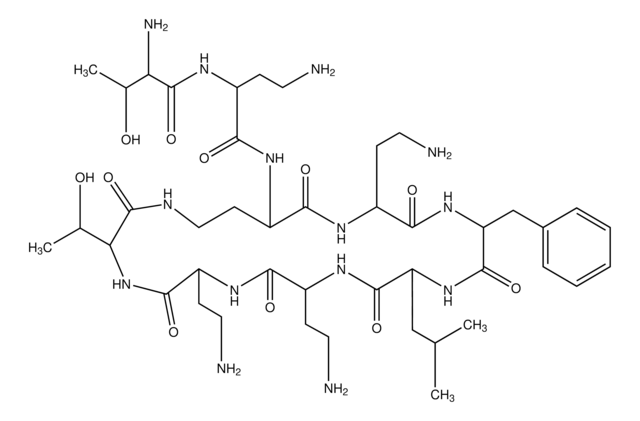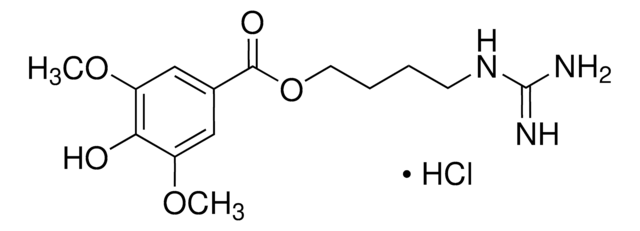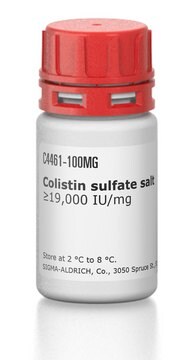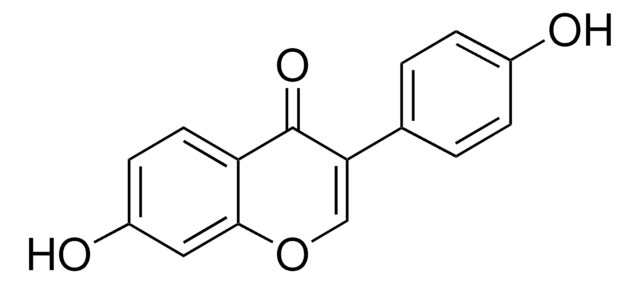SBR00029
Dansyl labeled polymyxin B Ready Made Solution
for fluorescent microbial imaging, 1.5 mg/mL in H2O
Synonym(s):
DSL-PMB, DSL-PMX, DSL-PxB
Sign Into View Organizational & Contract Pricing
All Photos(1)
About This Item
UNSPSC Code:
51102829
NACRES:
NA.76
Recommended Products
Quality Level
form
solution
availability
not available in China
concentration
1.5 mg/mL in H2O
color
colorless to light brown
suitability
suitable for (Fluorescent detection of gram-negative bacteria)
suitable for (Microbiome)
suitable for microbiology
Mode of action
cell membrane
shipped in
ambient
storage temp.
−20°C
General description
Dansyl Polymyxin B (DSL-PMB) is a fluorescent derivative of Polymyxin B. Polymyxin B is a cationic lipopeptide antibiotic that binds specifically to Gram-negative bacteria. Fluorescent antibiotics are obtained by synthetic conjugation of an antibiotic to a fluorophore.
Dansyl labeled Polymyxin B can be utilized for fluorescent microbial imaging in the fields of Cell Biology and Biochemical research.
Application
DSL-PMB may have been used:
- as a fluorescent probe to study polymyxin mode of action and its pharmacokinetics
- in research and to develop new active derivatives of Polymyxin against multi-drug resistance Gram-negative infections
- to measure LPS binding affinity by fluorometric displacement assay
- Antimicrobial resistance research.
- Bacterial visualization and imaging.
- Parent antibiotic mode of action research and new antibiotic discovery.
- Toxicity studies.
- Research of bacterial infections and tracking its uptake in vivo.
Biochem/physiol Actions
DSL-PMB′s mode of action is in accordance with Polymyxin B activity. However, MIC assays comparing DSL-PMB, and parent Polymyxin B showed a two to three-fold decrease in bacterial activity. Polymyxin B interacts with anionic lipopolysaccharide (LPS) molecules which are located in Gram-negative bacterial outer membrane. This interaction interferes with the outer membrane′s normal function, causing leakage and enhanced uptake of the antibiotic. The resemblance in properties between Polymyxin B and DSL-PMB allows to fluorescently label Gram-negative bacteria and examine intracellular localization and penetration of Polymyxins in Gram-negative bacteria.
Features and Benefits
- High-quality antibiotic suitable for multiple research applications
- Ideal for Cell Biology, Metabolomics, and Biochemical research.
Analysis Note
- Dansyl Labeled Polymyxin B Ready Made Solution is light sensitive.
- It is recommended to avoid freeze-thaw cycles of PMB-DSL Ready Made Solution.
- Dansyl Labeled Polymyxin B Ready Made Solution (1.5 mg/mL) can be diluted 1:50 in PBSX1 (Sigma#D8537) to achieve 30 μg/mL final concentration for staining. The above concentration of DSL-PMB was used for E. coli staining see image.
- Fluorescence Microscopy application: Dansyl Labeled Polymyxin B Ready Made Solution excitation (Ex) wavelength is 330-340nm resulting in emission (Em) range of 540-600nm (λmax=570nm).
Other Notes
For additional information on our range of Biochemicals, please complete this form.
Storage Class Code
12 - Non Combustible Liquids
WGK
WGK 1
Flash Point(F)
Not applicable
Flash Point(C)
Not applicable
Choose from one of the most recent versions:
Certificates of Analysis (COA)
Lot/Batch Number
Sorry, we don't have COAs for this product available online at this time.
If you need assistance, please contact Customer Support.
Already Own This Product?
Find documentation for the products that you have recently purchased in the Document Library.
R A Moore et al.
Antimicrobial agents and chemotherapy, 30(6), 923-926 (1986-12-01)
Pseudomonas cepacia was found to be resistant to the outer membrane-permeabilizing effects of aminoglycoside antibiotics, polymyxin B, and EDTA. Permeabilization of P. cepacia to the fluorescent probe 1-N-phenylnaphthylamine was not achieved at concentrations 100- to 1,000-fold above those required to
P R Schindler et al.
Antimicrobial agents and chemotherapy, 8(1), 95-104 (1975-07-01)
Though the primary action of the cationic antibiotic polymyxin B is against the membrane of susceptible bacteria, severe morphological changes are detected in the cytoplasm. Using fluorescence microscopy and a mono-N-dansyl-polymyxin B derivative, we could demonstrate aggregations of the antibiotic
Vincent H Tam et al.
Antimicrobial agents and chemotherapy, 49(9), 3624-3630 (2005-08-30)
Despite limited data, polymyxin B (PB) is increasingly used clinically as the last therapeutic option for multidrug-resistant (MDR) gram-negative bacterial infections. We examined the in vitro pharmacodynamics of PB against four strains of Pseudomonas aeruginosa. Clonal relatedness of the strains
R E Hancock
Lancet (London, England), 349(9049), 418-422 (1997-02-08)
The era of the "classical antibiotic" may be over. The emergence of resistance has seen to that. Yet no truly novel class of antibacterial agent has come on the market in the past 30 years. Currently there is great interest
M E Evans et al.
The Annals of pharmacotherapy, 33(9), 960-967 (1999-09-24)
Polymyxin B sulfate and colistin, also known as colistimethate, have not been used for many years because less toxic antimicrobials are available. Gram-negative bacteria that are resistant to the aminoglycosides, beta-lactams, and fluoroquinolones are becoming more common. These bacteria are
Our team of scientists has experience in all areas of research including Life Science, Material Science, Chemical Synthesis, Chromatography, Analytical and many others.
Contact Technical Service